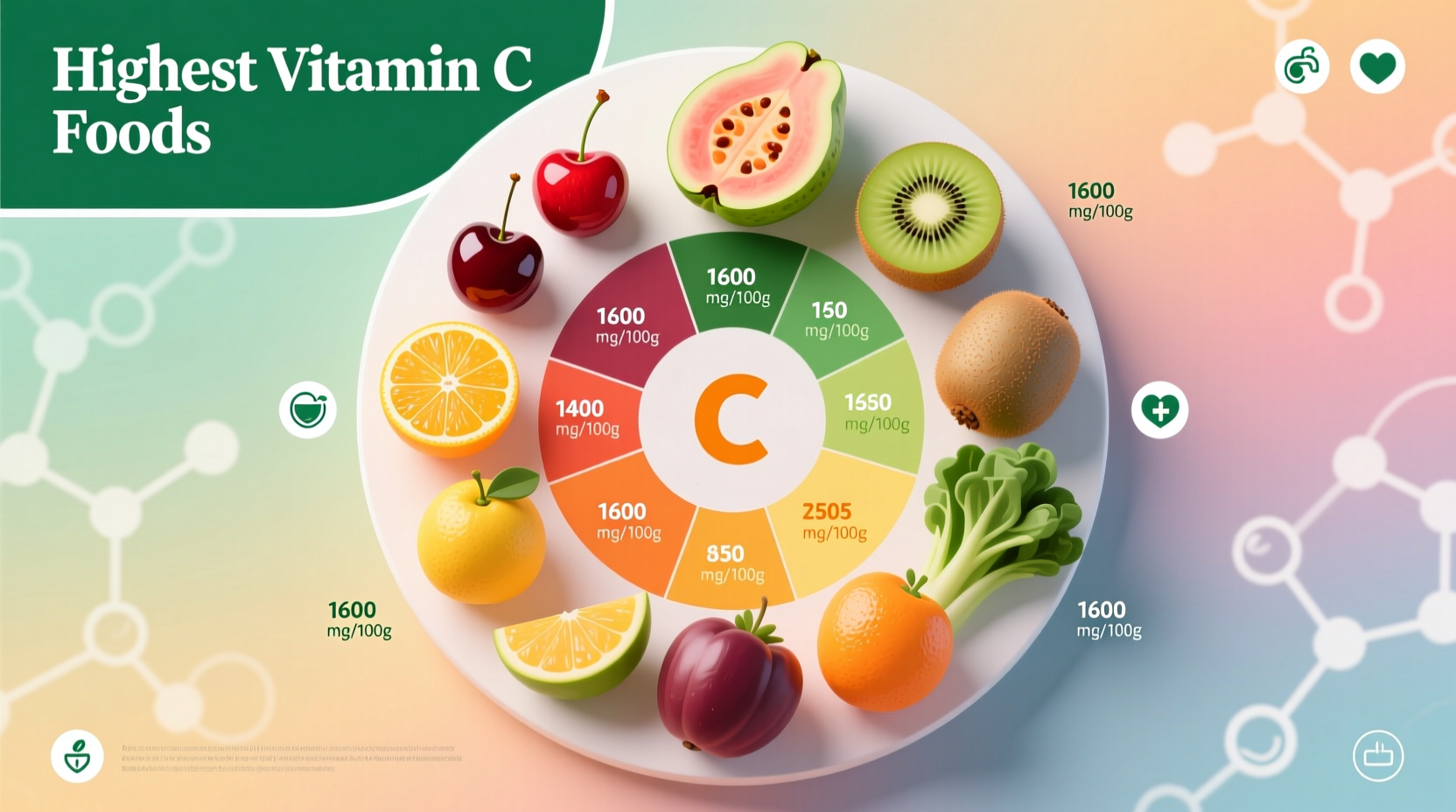When searching for the most potent natural sources of vitamin C, understanding exactly which foods provide the highest concentrations can transform your nutritional strategy. Vitamin C—essential for immune function, collagen synthesis, and antioxidant protection—varies dramatically across different foods. While citrus fruits dominate popular perception, several lesser-known options actually contain significantly higher concentrations.
Vitamin C Essentials: Why It Matters
Vitamin C (ascorbic acid) plays multiple critical roles in human health. The National Institutes of Health recommends 90mg daily for adult men and 75mg for women, with higher amounts needed during pregnancy, smoking, or illness. Unlike most animals, humans cannot synthesize vitamin C internally, making dietary intake essential.
Deficiency can lead to scurvy, characterized by fatigue, weakened immunity, and connective tissue problems. However, research from the National Academy of Medicine indicates that optimal intake may exceed minimum requirements for maximum health benefits.
Top Vitamin C Foods Ranked by Concentration
Based on USDA FoodData Central measurements, here's how various foods compare in vitamin C content per 100g serving:
| Food | Vitamin C (mg/100g) | Percent Daily Value | Key Characteristics |
|---|---|---|---|
| Kakadu plum (raw) | 2,300-5,300 | 2,555-5,888% | Australian native, seasonal availability |
| Camu camu (frozen) | 2,145-2,800 | 2,383-3,111% | Amazonian berry, tart flavor |
| Acerola cherry (raw) | 1,678 | 1,864% | Tropical fruit, seasonal |
| Guava (pink, raw) | 228 | 253% | Contains seeds, edible skin |
| Yellow bell pepper (raw) | 184 | 204% | Higher than red or green varieties |
| Blackcurrants (raw) | 181 | 201% | Strong flavor, seasonal |
| Strawberries (raw) | 59 | 66% | Seasonal availability affects content |
| Orange (navel, raw) | 53 | 59% | Most recognized source |
The USDA's FoodData Central database confirms these measurements through laboratory analysis of raw, unprocessed samples. Seasonal variations and growing conditions can affect actual vitamin C content in produce.
Understanding Vitamin C Preservation
Vitamin C is water-soluble and sensitive to heat, light, and oxygen. The European Food Safety Authority notes that cooking methods significantly impact retention:
- Raw consumption preserves maximum vitamin C
- Steaming retains more than boiling (which leaches into water)
- Cooking time directly correlates with vitamin C loss
- Cut surfaces oxidize faster than whole fruits
For foods like bell peppers—which contain more vitamin C than oranges—eating them raw in salads provides approximately 30% more vitamin C than when cooked. This context boundary matters when planning meals for maximum nutritional benefit.

Practical Vitamin C Boosting Strategies
Maximizing your vitamin C intake requires strategic planning beyond simply identifying high-content foods:
Seasonal Sourcing Approach
Align your consumption with natural growing seasons for peak vitamin C content:
- Winter: Citrus fruits reach peak vitamin C concentration
- Spring: Strawberries and young leafy greens provide excellent sources
- Summer: Bell peppers, tomatoes, and berries flourish
- Fall: Cruciferous vegetables like broccoli and Brussels sprouts peak
Combination Techniques
Pair vitamin C-rich foods with iron sources to enhance absorption. A study published in the American Journal of Clinical Nutrition demonstrated that 63mg of vitamin C (about one small orange) can increase iron absorption from plant foods by up to 4.5 times.
Vitamin C Timeline: From Scurvy Cure to Modern Understanding
The historical journey of vitamin C discovery provides context for its importance:
- 1747: James Lind's clinical trial established citrus fruits prevent scurvy
- 1928: Albert Szent-Györgyi isolates ascorbic acid (vitamin C)
- 1932: Vitamin C's chemical structure is identified
- 1933: First synthetic production of vitamin C
- 1970s: Linus Pauling popularizes high-dose vitamin C theory
- 2000s: Research expands understanding of vitamin C's role beyond scurvy prevention
This evolution shows how scientific understanding has progressed from preventing deficiency diseases to recognizing vitamin C's broader roles in health maintenance.
Addressing Common Vitamin C Misconceptions
Several persistent myths cloud understanding of vitamin C:
- Myth: Oranges are the best natural source of vitamin C
Reality: Many foods contain significantly higher concentrations, including bell peppers and tropical fruits - Myth: More vitamin C always provides better immunity
Reality: The body excretes excess vitamin C, and extremely high doses can cause digestive issues - Myth: Vitamin C supplements are equivalent to food sources
Reality: Whole foods provide additional phytonutrients that work synergistically with vitamin C
Practical Daily Integration
Creating a vitamin C-rich diet doesn't require exotic ingredients. Simple strategies include:
- Adding raw bell peppers to sandwiches and salads
- Using lemon or lime juice as dressing base
- Snacking on seasonal berries instead of processed sweets
- Adding fresh herbs like parsley and cilantro to dishes
- Choosing guava or kiwi instead of traditional fruit options
A single yellow bell pepper provides more than double the daily recommended vitamin C, making it an exceptionally efficient source for those seeking maximum nutritional benefit from everyday ingredients.











 浙公网安备
33010002000092号
浙公网安备
33010002000092号 浙B2-20120091-4
浙B2-20120091-4